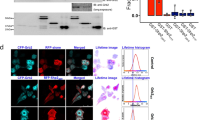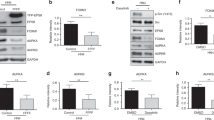Abstract
Control mechanisms that prevent aberrant signaling are necessary to maintain cellular homeostasis. We describe a new mechanism by which the adaptor protein Shc directly binds the MAP kinase Erk, thus preventing its activation in the absence of extracellular stimuli. The Shc–Erk complex restricts Erk nuclear translocation, restraining Erk-dependent transcription of genes, including those responsible for oncogenic growth. The complex forms through unique binding sites on both the Shc PTB domain and the N-terminal lobe of Erk. Upon receptor tyrosine kinase stimulation, a conformational change within Shc—induced through interaction with the phosphorylated receptor—releases Erk, allowing it to fulfill its role in signaling. Thus, in addition to its established role in promoting MAP kinase signaling in stimulated cells, Shc negatively regulates Erk activation in the absence of growth factors and thus could be considered a tumor suppressor in human cells.
This is a preview of subscription content, access via your institution
Access options
Subscribe to this journal
Receive 12 print issues and online access
$189.00 per year
only $15.75 per issue
Buy this article
- Purchase on Springer Link
- Instant access to full article PDF
Prices may be subject to local taxes which are calculated during checkout






Similar content being viewed by others
References
Davol, P.A., Bagdasaryan, T.P., Elfenbein, G.J., Maizel, A.I. & Frackleton, A.R. Jr. Shc proteins are strong independent markers for both node-negative and node-positive primary breast cancer. Cancer Res. 63, 6772–6783 (2003).
Frackleton, A.R. Jr. et al. p66 Shc and tyrosine phosphorylated Shc in primary breast tumors identify patients likely to relapse despite tamoxifen therapy. Breast Cancer Res. 8, R73 (2006).
Ursini-Siegel, J. & Muller, W. The ShcA protein is a critical regulator of breast cancer progression. Cell Cycle 7, 1936–1943 (2008).
Dankort, D. et al. Grb2 and Shc adaptor proteins play distinct roles in neu (Erb-2)-induced mammary tumorigenesis: implications for human breast cancer. Mol. Cell Biol. 21, 1540–1551 (2001).
Siegel, P.M., Shu, W.P., Cardiff, R.D., Muller, W.J. & Massague, J. Transforming growth factor β signaling impairs Neu-induced mammary tumorigenisis while promoting pulmonary metastasis. Proc. Natl. Acad. Sci. USA 100, 8430–8435 (2003).
Marone, R. et al. Memo mediates ErbB2-driven cell motility. Nat. Cell Biol. 6, 515–522 (2004).
Muraoka-Cook, R.S. et al. Conditional overexpression of active transforming growth factor β1 in vivo accelerates migration of transgenic mammary tumors. Cancer Res. 64, 9002–9011 (2004).
Muraoka-Cook, R.S. et al. Activated type I TGFβ receptor kinase enhances the survival of mammary epithelial cells and accelerated tumor progression. Oncogene 25, 3408–3423 (2006).
Ursini-Siegel, J. et al. Shc signaling is essential for tumour progression in mouse models of human breast cancer. EMBO J. 27, 910–920 (2008).
Northey, J.J. et al. Signaling through ShcA is required for TGFβ and Neu/ErbB-2-induced breast cancer cell motility and invasion. Mol. Cell Biol. 28, 3162–3176 (2008).
Audero, E. et al. Adaptor ShcA protein binds tyrosine kinase Tie2 receptor and regulates migration and sprouting but not survival of endothelial cells. J. Biol. Chem. 279, 13224–13233 (2004).
van der Geer, P., Wiley, S., Gish, G.D. & Pawson, T. The Shc adaptor protein is highly phosphorylated at conserved twin tyrosine residues (Y239/240) that mediate protein-protein interactions. Curr. Biol. 6, 1435–1444 (1996).
Ravichandran, K.S. et al. Evidence for a requirement for both phospholipid and phosphotyrosine binding via the Shc phosphotyrosine-binding domain in vivo. Mol. Cell Biol. 17, 5540–5549 (1997).
Sweet, D.T. & Tzima, E. Spatial signaling networks converge at the adaptor protein Shc. Cell Cycle 8, 231–235 (2009).
George, R., Schüller, A.C., Harris, R. & Ladbury, J.E. A phosphorylation-dependent gating mechanism controls the SH2 domain interactions of the Shc adaptor protein. J. Mol. Biol. 377, 740–747 (2008).
Ursini-Siegel, J. et al. The ShcA SH2 domain engages a 14-3-3/PI3′K signaling complex and promotes breast cancer cell survival. Oncogene 31, 5038–5044 (2012).
Kolch, W. Coordinating ERK/MAPK signaling through scaffolds and inhibitors. Nat. Rev. Mol. Cell Biol. 6, 827–837 (2005).
Garrington, T.P. & Johnson, G.L. Organization and regulation of mitogen-activated protein kinase signaling pathways. Curr. Opin. Cell Biol. 11, 211–218 (1999).
Steinmetz, R. et al. Mechanisms regulating the constitutive activation of the extracellular signal-regulated kinase (ERK) signaling pathway in ovarian cancer and the effect of ribonucleic acid interference for ERK1/2 on cancer cell proliferation. Mol. Endocrinol. 18, 2570–2582 (2004).
Price, D.T. et al. Activation of extracellular signal-regulated kinase in human prostate cancer. J. Urol. 162, 1537–1542 (1999).
Zheng, B. et al. MEK/ERK pathway is aberrantly active in Hodgkin disease: a signaling pathway shared by CD30, CD40 and RANK that regulates cell proliferation and survival. Blood 102, 1019–1027 (2003).
Fukuda, M., Gotoh, Y. & Nishida, E. Interaction of MAP kinase with MAP kinase kinase: its possible role in the control of nucleocytoplasmic transport of MAP kinase. EMBO J. 16, 1901–1908 (1997).
Yoon, S. & Seger, R. The extracellular signal-regulated kinase: multiple substrates regulate diverse cellular functions. Growth Factors 24, 21–44 (2006).
Arur, S. et al. Multiple ERK substrates execute single biological processes in Caenorhabdtis elegans germ-line development. Proc. Natl. Acad. Sci. USA 106, 4776–4781 (2009).
Carlson, S.M. et al. Large-scale discovery of ERK2 substrates identifies ERK-mediated transcriptional regulation by ETV3. Sci. Signal. 4, rs11 (2011).
Khokhlatchev, A.V. et al. Phosphorylation of the MAP kinase ERK2 promotes its homodimerization and nuclear translocation. Cell 93, 605–615 (1998).
Marshall, C.J. Specificity of receptor tyrosine kinase signaling: transient versus sustained extracellular signal-regulated kinase activation. Cell 80, 179–185 (1995).
Murphy, L.O. & Blenis, J. MAPK signal specificity: the right place at the right time. Trends Biochem. Sci. 31, 268–275 (2006).
Dougherty, M.K. et al. Regulation of Raf-1 by direct feedback phosphorylation. Mol. Cell 17, 215–224 (2005).
Schüller, A.C. et al. Indirect recruitment of the signalling adaptor Shc to the fibroblast growth factor receptor 2 (FGFR2). Biochem. J. 416, 189–199 (2008).
Murshudov, G.N., Vagin, A.A. & Dodson, E.J. Refinement of macromolecular structures by the maximum likelihood method. Acta Crystallogr. D Biol. Crystallogr. 53, 240–255 (1997).
Zhou, M.M. et al. Structure and ligand recognition of the phosphotyrosine binding domain of Shc. Nature 378, 584–592 (1995).
Akella, R., Moon, T.M. & Goldsmith, E.J. Unique MAP kinase binding sites. Biochim. Biophys. Acta 1784, 48–55 (2008).
Treisman, R. The serum response element. Trends Biochem. Sci. 17, 423–426 (1992).
Lee, M.H. et al. Multiple functions and dynamic activation of MPK-1 extracellular signal-regulated kinase signaling in Caenorhabditis elegans germline development. Genetics 177, 2039–2062 (2007).
Arur, S. et al. MPK-1 ERK controls membrane organization in C. elegans oogenesis via a sex-determination module. Dev. Cell 20, 677–688 (2011).
Farooq, A., Zeng, L., Yan, K.S., Ravichandran, K.S. & Zhou, M.M. Coupling of folding and binding in the PTB domain of signaling protein Shc. Structure 11, 905–913 (2003).
Lin, C.-C. et al. Inhibition of basal FGF receptor signaling by dimeric Grb2. Cell 149, 1514–1524 (2012).
Ravichandran, K.S. Signaling via Shc family adapter proteins. Oncogene 20, 6322–6330 (2001).
Hardy, W.R. et al. Combinatorial ShcA docking interactions support diversity in tissue morphogenesis. Science 317, 251–256 (2007).
George, R. et al. A complex of Shc and Ran-GTPase localises to the cell nucleus. Cell Mol. Life Sci. 66, 711–720 (2009).
Ramos, J.W. The regulation of extracellular signal-regulated kinase (ERK) in mammalian cells. Int. J. Biochem. Cell Biol. 40, 2707–2719 (2008).
Bhattacharyya, R.P. et al. The Ste5 scaffold allosterically modulates signaling output of the yeast mating pathway. Science 311, 822–826 (2006).
Ugi, S., Imamura, T., Ricketts, W. & Olefsky, J.M. Protein phosphatase 2A forms a molecular complex with Shc and regulates Shc tyrosine phosphorylation and downstream mitogenic signaling. Mol. Cell Biol. 22, 2375–2387 (2002).
Formstecher, E. et al. PEA-15 mediates cytoplasmic sequestration of ERK MAP kinase. Dev. Cell 1, 239–250 (2001).
Morrison, D.K. & Davis, R.J. Regulation of MAP kinase signaling modules by scaffold proteins in mammals. Annu. Rev. Cell Dev. Biol. 19, 91–118 (2003).
Torii, S., Kusakabe, M., Maekawa, M. & Nishuda, E. Sef is a spatial regulator for Ras/MAP kinase signaling. Dev. Cell 7, 33–44 (2004).
Konarev, P.V., Petoukhov, M.V., Volkov, V.V. & Svergun, D.I. ATSAS 2.1, a program package for small-angle scattering data analysis. J. Appl. Crystallogr. 39, 277–286 (2006).
Harvey, C.D. A genetically encoded fluorescent sensor of ERK activity. Proc. Natl. Acad. Sci. USA 105, 19264–19269 (2008).
Ahmed, Z., Schüller, A.C., Suhling, K., Tregidgo, C. & Ladbury, J.E. Extracellular point mutations in FGFR2 elicit unexpected changes in intracellular signaling. Biochem. J. 413, 37–49 (2008).
Brenner, S. The genetics of Caenorhabditis elegans. Genetics 77, 71–94 (1974).
Church, D.L., Guan, K.L. & Lambie, E.J. 3 Genes of the Map kinase cascade, Mek-2, Mpk-1/Sur-1 and Let-60 Ras, are required for meiotic cell-cycle progression in Caenorhabditis elegans. Development 121, 2525–2535 (1995).
Eisenmann, D.M. & Kim, S.K. Mechanism of activation of the Caenorhabditis elegans ras homologue let-60 by a novel, temperature-sensitive, gain-of-function mutation. Genetics 146, 553–565 (1997).
Lackner, M.R. & Kim, S.K. Genetic analysis of the Caenorhabditis elegans MAP kinase gene mpk-1. Genetics 150, 103–117 (1998).
Hodgkin, J. Sex, cell death, and the genome of C. elegans. Cell 98, 277–280 (1999).
Arur, S. et al. Multiple ERK substrates execute single biological processes in Caenorhabdtis elegans germ-line development. Proc. Natl. Acad. Sci. USA 106, 4776–4781 (2009).
Francis, R., Barton, M.K., Kimble, J. & Schedl, T. Gld-1, a tumor-suppressor gene required for oocyte development in Caenorhabditis elegans. Genetics 139, 579–606 (1995).
Jones, A.R., Francis, R. & Schedl, T. GLD-1, a cytoplasmic protein essential for oocyte differentiation, shows stage- and sex-specific expression during Caenorhabditis elegans germline development. Dev. Biol. 180, 165–183 (1996).
Lee, M.H. et al. Multiple functions and dynamic activation of MPK-1 extracellular signal-regulated kinase signaling in Caenorhabditis elegans germline development. Genetics 177, 2039–2062 (2007).
Acknowledgements
J.E.L. is funded by the G. Harold and Leila Y. Mathers Charitable Foundation and the University of Texas MD Anderson Cancer Center Trust. S.A. is funded through US National Institutes of Health GM98200. C. elegans strains were obtained through the Center for Caenorhabditis elegans consortium funded by the US National Institutes of Health National Center for Research Resources. We thank A. Radhakrishnan for the preparation of protein samples used in SAXS analysis and A.C. Schüller for assistance with western blots. MKN28 cells and MCF7 cells were kind gifts from R.M. Peek (Division of Gastroenterology, Vanderbilt University Medical Center, Nashville, Tennessee, USA) and P.H. Brown (Department of Clinical Cancer Prevention, University of Texas, MD Anderson Cancer Center, Houston, Texas, USA), respectively. We thank the Berkeley Laboratory Advanced Light Source and SIBYLS beamline staff at bl12.3.1 for assistance with collection of SAXS data.
Author information
Authors and Affiliations
Contributions
K.M.S., C.-C.L., R.G., F.A.M., E.R.B., Z.A. and S.T.A. carried out experiments and analyzed data. K.M.S., M.N.D. and S.A. performed the C. elegans experiments and analyzed the data. K.M.S., S.A., S.T.A. and J.E.L. conceived of the experiments and wrote the manuscript.
Corresponding author
Ethics declarations
Competing interests
The authors declare no competing financial interests.
Supplementary information
Supplementary Text and Figures
Supplementary Figures 1–4, Supplementary Table 1 and Supplementary Note (PDF 513 kb)
Rights and permissions
About this article
Cite this article
Suen, K., Lin, CC., George, R. et al. Interaction with Shc prevents aberrant Erk activation in the absence of extracellular stimuli. Nat Struct Mol Biol 20, 620–627 (2013). https://doi.org/10.1038/nsmb.2557
Received:
Accepted:
Published:
Issue Date:
DOI: https://doi.org/10.1038/nsmb.2557
This article is cited by
-
Grb2 binding induces phosphorylation-independent activation of Shp2
Communications Biology (2021)
-
Grb2 monomer–dimer equilibrium determines normal versus oncogenic function
Nature Communications (2015)



